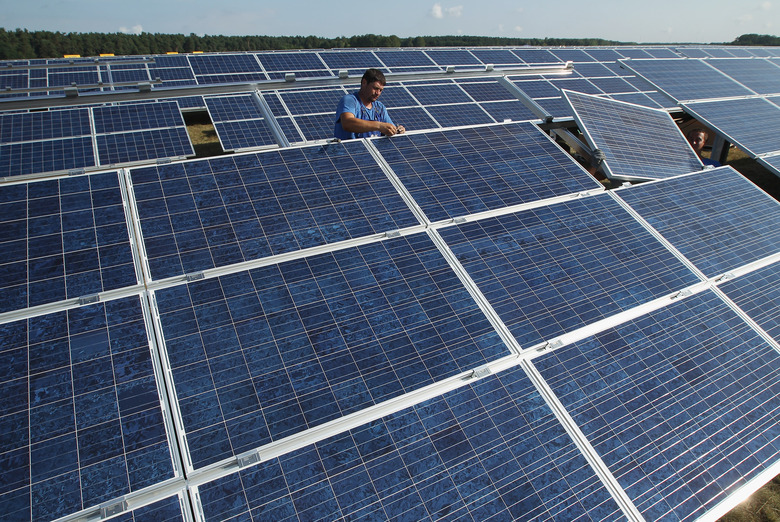The Effects Of Temperature On Solar Panel Power Production
Photovoltaic solar panels convert sunlight into electricity, so you would think that the more sunlight, the better. That's not always true, because sunlight consists not only of the light that you see, but also of invisible infrared radiation, which carries heat. Your solar panel will perform great if it gets a lot of light, but as it gets hotter, its performance degrades.
Energy From Photovoltaics
Energy From Photovoltaics
Photovoltaic solar panels are assemblies of individual cells made of semiconductor material. The voltage a solar cell puts out is mostly determined by the choice of semiconductor and the details of the semiconductor layers. Silicon solar cells — the most common choice — put out about half a volt from each cell. The current generated by a solar cell is a function of the amount of sunlight that hits it. The more sunlight that hits it, the more current it will generate, up to the limits of the cell. Electrical power is the product of the current times the voltage. A small solar panel could have 36 cells wired together to produce about 18 volts total at a current of 2 amps. That solar panel would be rated for 18 volts x 2 amps = 36 watts of peak power. If it is illuminated for an hour then it will generate 36 watt-hours of energy.
Voltage Drop
Voltage Drop
Solar panel manufacturers test their products at standard conditions of 25 degrees Celsius (77 degrees Fahrenheit) with an insolation of 1,000 watts per square meter. Insolation is a measure of how much solar power is hitting each square meter perpendicular to the direction of the sunlight. The insolation can be higher than 1,000 watts per square meter around noon on very clear days, and that will make your solar panel generate more current, which means more power. Unfortunately, it's a different story with temperature. As the temperatures of the solar cells rise above 25 degrees Celsius, the current rises very slightly, but the voltage decreases more rapidly. The net effect is a decrease in output power with increasing temperature. Typical silicon solar panels have a temperature coefficient of about -0.4 to -0.5 percent. This means that for every degree Celsius above 25, the power output from the array would drop by that percentage. At 45 degrees Celsius (113 degrees Fahrenheit), a 40-watt solar panel with a temperature coefficient of -0.4 would produce less than 37 watts.
Offsetting Temperature
Offsetting Temperature
Your solar panel performance is quoted for 25 degrees Celsius, and it decreases as temperature rises. Luckily, it increases again as the temperature falls. If you're in a temperate region, the performance that you lose in the summer heat will be returned on cool, clear winter days. If that's not enough consolation for you, you can also build your solar array to take advantage of the natural cooling effects of wind — channeling currents to carry heat away from your solar panels. For roof-mounted systems this can be as simple as making sure you leave 6 inches of space between your panels and your roof. You can take a more active approach to cooling by using evaporative cooling — using the evaporation of water to cool your panels in the same way sweat cools your skin on a hot day.
Other Solar Materials
Other Solar Materials
An alternative to traditional silicon solar panels comes in the form of thin-film panels. They're made with different semiconductor materials, and their temperature coefficient is only about half that of silicon. Thin-film panels don't start with as high an efficiency as crystalline silicon photovoltaics, but their lower sensitivity to higher temperatures makes them an attractive option for very hot locations. Thin film panels are used exactly the same way as their crystalline counterparts, but they are typically a couple percent less efficient. Their temperature coefficient ranges from about -0.2 to -0.3 percent. There are other crystalline materials that start with higher efficiency than silicon and also have a positive temperature coefficient. That means they get better as the temperature increases. They're also very expensive, which limits their use to some specialized applications. Eventually, though, they could make their way to residential homes.
Cite This Article
MLA
Gaughan, Richard. "The Effects Of Temperature On Solar Panel Power Production" sciencing.com, https://www.sciencing.com/effects-temperature-solar-panel-power-production-19442/. 24 April 2017.
APA
Gaughan, Richard. (2017, April 24). The Effects Of Temperature On Solar Panel Power Production. sciencing.com. Retrieved from https://www.sciencing.com/effects-temperature-solar-panel-power-production-19442/
Chicago
Gaughan, Richard. The Effects Of Temperature On Solar Panel Power Production last modified March 24, 2022. https://www.sciencing.com/effects-temperature-solar-panel-power-production-19442/
